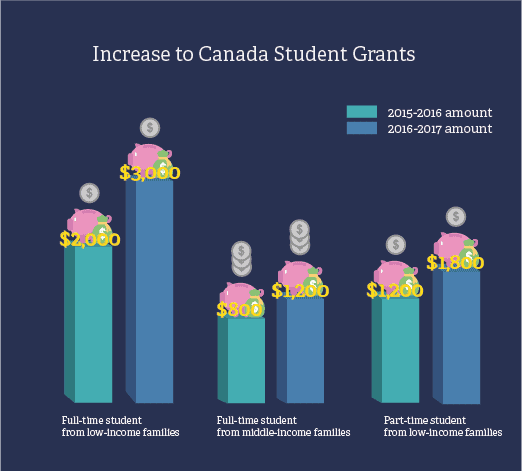Paying for post-secondary education just became a little less stressful for students from low-income and middle-income families.
Employment and Social Development Canada announced on July 28 that Canada Student Grants (CSGs) will go up by 50 per cent, impacting over 350,000 students as of August 1. Starting this school year, full-time low-income students will receive $3,000 per year, an increase from $2000 per year; part-time low-income students can expect $1,800 per year instead of $1,200; and full-time middle-income students will be getting $1,200 in place of $800. Over the next five years, $1.53 billion in CSGs is expected to financially assist students.
The federal government also made changes to the Repayment Assistance Plan (RAP); borrowers do not have to repay their loans until they are annually making at least $25,000. This change will officially start on November 1.
“As a result of these new measures, post-secondary education will be more affordable, and students will be better positioned to transition into the workforce after graduation,” said MaryAnn Mihychuk, Minister of Employment, Workforce Development and Labour, in a press release on the Government of Canada’s website.
Jasmine Wong Denike, President of the University of Toronto Students’ Union (UTSU), praised these changes. Last year, the UTSU became a founding member of ADVOCAN, a body of Canadian student organizations that lobbied the Federal Government to reform CSGs and Canada Student Loans, as well as RAP.
“We’re very pleased to have been listened to,” said Denike.
Denike added that even the $3,000 for full-time low-income students would not cover half of what U of T Arts & Science students pay per year. Denike had a similar sentiment toward the RAP, saying that the changes were good, but that $25, 000 per year isn’t a lot of money. “The rate at which you need to pay off your debt should be tied to your annual income. Someone earning $50,000 shouldn’t need to pay back as much per year as someone earning $100,000,” said Denike.
For the 2017–2018 year, more financial assistance may become available to students through a proposed “flat-rate student contribution,” in which students annually pay a “flat amount” toward their post-secondary education, instead of having their eligibility for Canada Student Loans and Grants decided by their income and financial assets during the school year.


